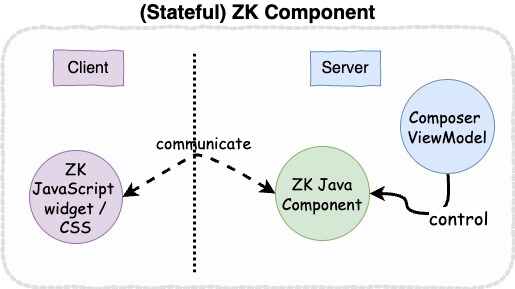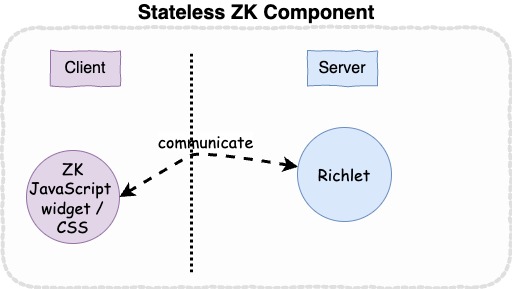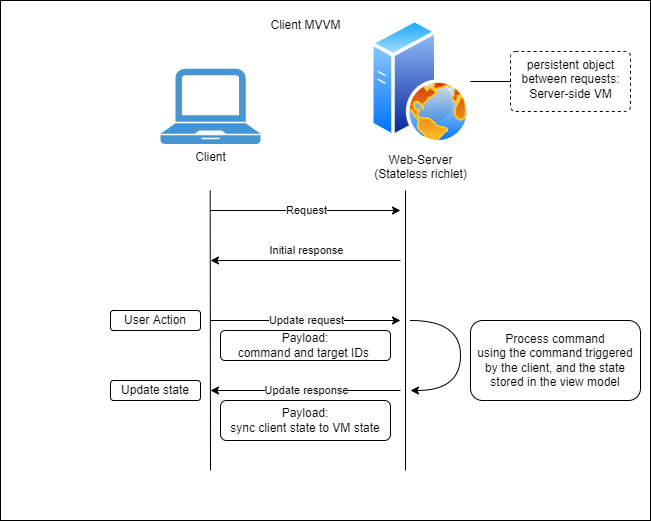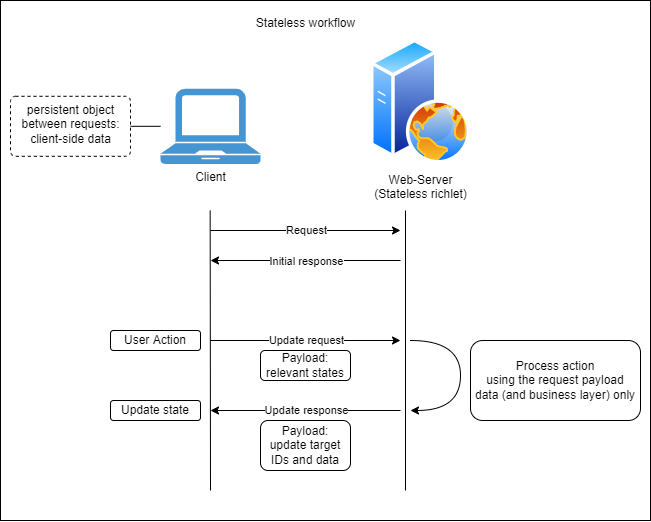Stateless Components
Since 10.0.0
- Available for ZK:
-

Overview
Classic ZK overview
Classic ZK components are stored in the HttpSession on the server side. Based on the Java EE Web application specification, a session is an object that exists in memory on the server side. When a web browser sends a request to the server, it also sends a session identifier. This is commonly done with a JSESSIONID cookie or through a URL parameter.
Based on this identifier, the Web Server will retrieve the session object from memory and make it available while processing the response to the user's request. This allows the server-side application to store various objects semi-permanently in the server's memory until the session is destroyed.
In the classic use case, the page generated by ZK exists in the session. When the user triggers an action or changes the state of a component on the client side, a request is sent to the server and updates the "main state" of the components that exist in the session. In this workflow, the server-side state is authoritative, and the client state is synchronized based on the server-side state.
Stateless components overview
The stateless components are not stored in the server's memory. They are transient objects which only exist during the user's request and response cycle.
In this case, the authoritative state is located on the client side. Updates performed with Stateless components are done on a "per action" basis.
Each action has a set of "Action parameters", which indicates what data needs to be retrieved from the client in order to process a given action. This way, no server-side record of the page's state is required. When the user triggers an action, the client-side engine will fetch the properties and values requested by the action and send all relevant data in the request.
The server-side action will then process any relevant update based on that data and the event triggered by the user. At the end of that processing, the action may modify the client's state and send a response that will write the new state on the client side.
During this process, the action only used the information retrieved by the action parameters. As such, it did not need to access any data located on the server side. s.
Differences Between Classic ZK Components and Stateless Components
Component State Management
- Classic: Stored in the HttpSession on the server side, maintaining states in the server's memory for semi-permanent object storage.
- Stateless: Not stored in server memory, existing only during the user's request-response cycle. The state is stored in a browser.
State Authority
- Classic: Server-side authoritative state, with client-side state synchronized based on the server-side state.
- Stateless: Client-side authoritative state, with updates performed on a per-action basis.
Data Processing and Memory Usage
- Classic: Maintain consistent state across user interactions, requiring more server memory for state retention.
- Stateless: Lower memory footprint due to lack of need for server-side state record between transactions.
Use Cases and Suitability
- Classic: Suitable for applications requiring server-side permanence, and traditional web infrastructure.
- Stateless: Ideal for distributed infrastructures with session replication, applications with limited server-side memory, and services needing high scalability, like cloud-native applications.
Advantages: Scalability, cloud readiness, and resource efficiency
The Stateless Components offer several advantages:
- Scalability: They adapt easily to varying workloads, making them ideal for cloud-native applications.
- Cloud Readiness: Simplifies deployment and management of applications in cloud environments.
- Resource Efficiency: Reduces server memory usage as there is no need to maintain component state on the server.
Limitations
WebSocket Not Supported
Since WebSocket is a stateful connection, it's not supported for StatelessRichlet.
Cannot Work with Stateful Components
Stateless and classic components cannot be used on one page together. The basic architecture for these components is different. Using them in one application is also not supported.
But a combination of Iframes and ZK's embedded features can effectively bring stateless and classic components together. For example, the main page could have an Iframe targeting a ZK stateless service. In contrast, another panel with more direct interaction could contain a classic ZK page added by ZK Embedded API.
FAQ
Are Stateless components an upgrade to classic ZK components
No. Stateless components are a branching technology from the classic ZK components. They use the same client-side code (the JavaScript Widgets and associated HTML and CSS code), in addition to a completely different communication and update layer.
How to handle use cases that require server-side permanence
While the Stateless components only exist during requests and responses, you may need to store data that the users should not be able to modify or data that should not be publicly accessible.
In this situation, some sort of shared permanence layer is necessary for the application's function. For this purpose, a good option is to use a database layer. In the stateless components demo application, the content of the user's shopping basket is stored in a database. Since the data layer is decoupled from the web container, it can be accessed by any number of instances. Databases already provide replication and high availability features, which makes them a great candidate to act as the shared permanence layer.
I have an existing ZK application...
... using classic ZK, do I need to migrate my code to use Stateless components instead?
It depends on your requirements. We do not see the Stateless component as "the next step" in ZK innovation. Instead, we see them as a convenient tool that can be used if they are relevant to a specific application's architecture requirements.
As a rule of thumb, consider the following.
I should use stateless components if:
- I'm developing an application for a heavily distributed infrastructure in which session replication between nodes is difficult to achieve (cloud hosting, high availability with multiple regional clusters, etc.)
- I'm developing smaller-scale services that do not need to know about each other to perform their functions.
- I do not have access to sticky sessions, which causes the active node for a given user to change with each request
- I am concerned about the memory footprint, I would like to minimize the memory used on the server side.
I should use classic ZK if:
- I already have a fully functional application, which matches my infrastructure needs
- My infrastructure is a classic "Database, webserver (or webserver cluster), gateway/reverse proxy"
- I need to store multiple data, states, and other semi-permanent objects between requests
- My application has a lot of interdependent systems that rely on server-side communication
Comparing and contrasting the Stateless workflow, and the new ZK 10 Client-MVVM features
Both of these new features' goal is to improve the resource footprint of a given page on the server side. There is a similar concept between both features: removing server-side component instances.
In the case of Client-side MVVM, the ClientBindComposer will keep track of the bindings and commands but not create corresponding ZK components (the textboxes, grids, buttons, etc) in the server memory.
The view model being already decoupled from the view doesn't need to know that the command comes from a server-side Java instance of Textbox, or if it was sent by the client, and forwarded directly by the ClientBindComposer. In the opposite direction, the client-side Textbox JavaScript object doesn't know if the update returned by the response is generated by a server-side Java Textbox object or forwarded directly from the view model by the ClientBindComposer.
In the case of stateless components, the Java-side objects are also removed. Instead of maintaining a state in the view model, and using the ClientBindComposer to forward that state to the client-side objects, the stateless workflow uses a list of inputs and outputs for each user action in a pattern that is closer to MVC.
When a user triggers an action on the client side, all the state data required to process that action is sent together with the request. As a result, there is no state at all located in server memory.
Can stateless components work with server push?
Stateless components in ZK, due to their architectural nature, present certain limitations when it comes to working with server push mechanisms. Unlike classic ZK components that maintain their state on the server, stateless components are designed to be transient, with their state predominantly managed on the client side. This design choice significantly reduces server-side memory footprint but also impacts how stateless components interact with server push technologies.
Server push, typically used to update client-side UI elements from the server in real time, relies on a persistent connection between the client and the server. In the context of stateless components, it's not supported to use server push.



